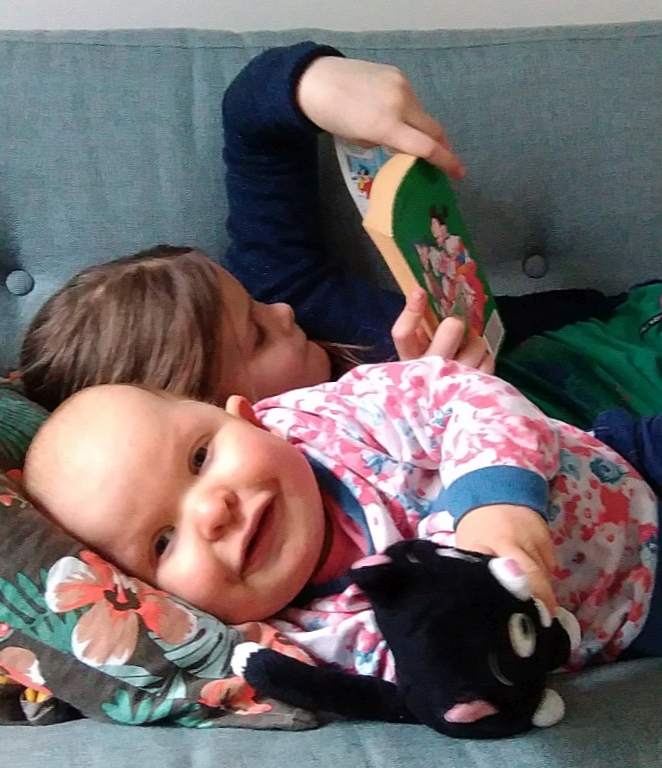It’s bedtime, but first… the shot! Vera is prepared. Every evening before bedtime she gets a shot. In her buttock. Small buttock, because that’s why she gets these shots: she is small. Even small for her syndrome. But there are additional reasons for the shot.
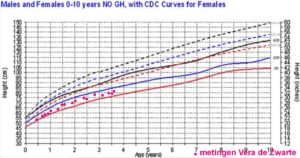 One of the characteristics of Costello syndrome is slow growth or lack of growth. Adult women who are affected by Costello have an average height of 1.35 m. (4 ft. 4) Vera’s sister Mieke is already taller than that at age 9, so we can get a good picture of how little grown-up Vera will be. And currently, with a height of 85 cm (2 ft. 7), she is very small for a 4.5-year-old. We knew Vera would be small, it is part of her genetic condition after all. But Vera is even below the adjusted growth curve for Costello syndrome. Because many children with Costello syndrome have reduced levels of growth hormones it seemed only logical to have her levels tested at WKZ (Wilhelmina Children’s Hospital). We knew from many parents of children with Costello syndrome that many of them were receiving growth hormone treatment to supplement the shortage to normal levels. And so, we added a new specialist to our list: the endocrinologist.
One of the characteristics of Costello syndrome is slow growth or lack of growth. Adult women who are affected by Costello have an average height of 1.35 m. (4 ft. 4) Vera’s sister Mieke is already taller than that at age 9, so we can get a good picture of how little grown-up Vera will be. And currently, with a height of 85 cm (2 ft. 7), she is very small for a 4.5-year-old. We knew Vera would be small, it is part of her genetic condition after all. But Vera is even below the adjusted growth curve for Costello syndrome. Because many children with Costello syndrome have reduced levels of growth hormones it seemed only logical to have her levels tested at WKZ (Wilhelmina Children’s Hospital). We knew from many parents of children with Costello syndrome that many of them were receiving growth hormone treatment to supplement the shortage to normal levels. And so, we added a new specialist to our list: the endocrinologist.
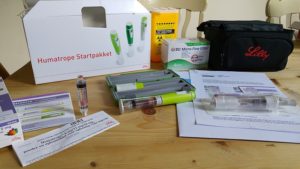
starter
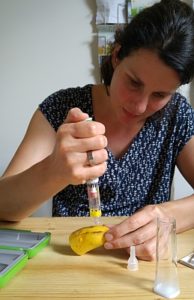
practice to give a shot on a banana
The trajectory started with a testing day (administering arginine), which showed that Vera does have adequate growth hormone levels (her pituitary gland does make growth hormones), but her body is not processing it. The cells in your body are supposed to make IGF-1 (insulin-like growth factor 1) in reaction to growth hormones, but this isn’t happening in Vera’s body. This not only affects her growth, but also her bone growth, muscle development, blood sugar levels and supports heart functioning. Many parents we talked to reported that their children slept better and had more energy after receiving growth hormone treatment.
After the testing day we started a trial period: administering growth factor IGF-1, that’s what’s in her shot. Luckily, Vera’s body responded well to this, her levels went up noticeably. But in order to start ongoing daily treatment, a lot of consulting had to be done by many doctors to make sure it was safe to give this to Vera. Because, due to the complexity of her condition there is always a bit more uncertainty and less experience with the long-term effects of the new treatment. The most important question was: could the reduced levels of growth hormones in Vera’s body be protecting her against something that would be undone if we started treatment? At the conference in Manchester we had already learned that there is no direct correlation between administering growth hormones and incorrect cell division. If this were the case, we wouldn’t want to do the treatment, because with Costello there is already a greater chance of developing tumors, we wouldn’t want to make this chance even greater. After reading many articles, talking to other parents and of course consulting the doctors, we came to the conclusion that administering growth hormones does not have any proven risks but that it does have proven benefits. With that, we could start her daily treatment – indefinitely, with check-ups at set points. Luckily, our insurer agreed, because it is a rather pricey medicine and we can’t just pick it up at our local regular pharmacy, we have to go to the hospital pharmacy in Utrecht.
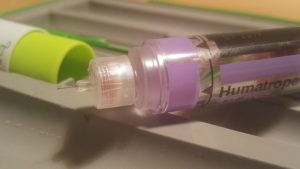 And so, the shot in our refrigerator was born. It took some getting used to. We ourselves already had to learn so many medical procedures to care for Vera, and not all of them are pleasant, with this one in particular, giving a shot, it was the first one in which we have to cause our child a little pain for her own good. Of course, she has had dozens of shots and we always held her and comforted her, but now we are the ones administering the shot. It took some getting used to, but after two weeks, we all adjusted, including Vera. The shot is part of it, it only takes a second and Vera is enormously brave; usually she allows it to happen willingly and she doesn’t make a sound. She does like to have control over who can give her the shot (mom or dad?) and where she wants to lie down for the shot. Because she may be small, but she has a big personality.
And so, the shot in our refrigerator was born. It took some getting used to. We ourselves already had to learn so many medical procedures to care for Vera, and not all of them are pleasant, with this one in particular, giving a shot, it was the first one in which we have to cause our child a little pain for her own good. Of course, she has had dozens of shots and we always held her and comforted her, but now we are the ones administering the shot. It took some getting used to, but after two weeks, we all adjusted, including Vera. The shot is part of it, it only takes a second and Vera is enormously brave; usually she allows it to happen willingly and she doesn’t make a sound. She does like to have control over who can give her the shot (mom or dad?) and where she wants to lie down for the shot. Because she may be small, but she has a big personality.
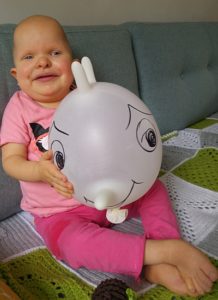 And, does it help? Vera has been receiving the treatment for 5 months now. The dosage has been increased once because she is still not at normal levels of IGF-1. But Vera is growing and it does seem to go faster than before. She does seem to sleep a teensy bit better on average. We do not see an increase in energy levels yet, but that has a lot to do with her heart condition (more about this later). As with all things, we are patient with this and will see what will happen in the long term. So for now, we will continue with our small shot for our big little Vera.
And, does it help? Vera has been receiving the treatment for 5 months now. The dosage has been increased once because she is still not at normal levels of IGF-1. But Vera is growing and it does seem to go faster than before. She does seem to sleep a teensy bit better on average. We do not see an increase in energy levels yet, but that has a lot to do with her heart condition (more about this later). As with all things, we are patient with this and will see what will happen in the long term. So for now, we will continue with our small shot for our big little Vera.

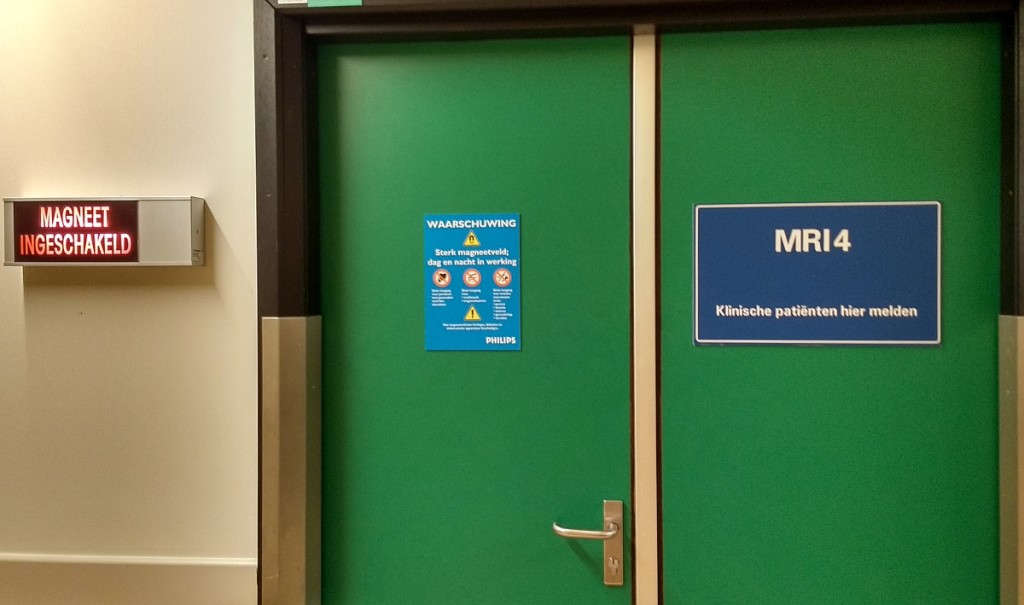 But it turned out summer was her best moment. In August she started regressing again. She made it clear she was in pain more often (during the day, but also at night, despite sleep medication she would wake suddenly and cry loudly), she didn’t want to sit on the potty any more and was walking less and less. She went from walking from the garden gate to the square near our house to a few steps in the living room and sitting or laying down again, simply because she couldn’t do it. She often pointed to her leg or knee hurting and made the gesture for doctor. This was not only noticeable at home but at her therapeutic preschool as well.
But it turned out summer was her best moment. In August she started regressing again. She made it clear she was in pain more often (during the day, but also at night, despite sleep medication she would wake suddenly and cry loudly), she didn’t want to sit on the potty any more and was walking less and less. She went from walking from the garden gate to the square near our house to a few steps in the living room and sitting or laying down again, simply because she couldn’t do it. She often pointed to her leg or knee hurting and made the gesture for doctor. This was not only noticeable at home but at her therapeutic preschool as well.
